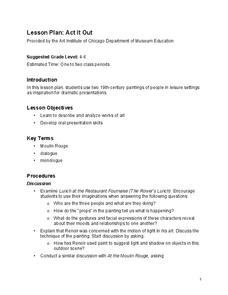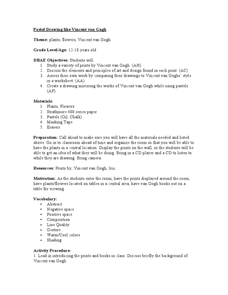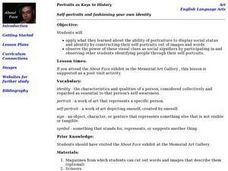Florida Alliance for Arts Education
Theatre Arts
What skills do storytellers employ to bring to life the characters and events in their tales? After listening to a recording of a Haitian folk tale, class members consider how tone of voice, pace, and gestures can be used to enliven a...
Curated OER
Pantomime vs. Abstract Gesture
Students explain dance as a way to create and communicate meaning and demonstrate the difference between pantomiming and abstracting a gesture.
Curated OER
Thanksgiving
Introduce the basics of Thanksgiving with a language arts instructional activity. As pupils practice observation skills, vocabulary, and reading comprehension, they design paper turkeys by outlining their hands and feet and by...
ESL Kid Stuff
Wheels on the Bus
Take a trip all around the town! Kids go round and round with a fun set of lessons based on "The Wheels on the Bus." After singing the song together, little learners figure out the hand gestures, reenact the song, and read an...
Curated OER
The Body Talks
Young historians examine the gestures of human subjects represented in Mannerist, Baroque and Renaissance paintings. After they play charades and attempt to match dialogue with body language, learners create a drawing that...
Curated OER
Rhythm and Art: Rhythm Collage
Students create a collage in response to musical rhythm. In this visual arts lesson plan, students will better understand the connection between visual arts and musical rhythm. Students will follow the teacher's model of letting the...
Curated OER
Gesture Drawing
Students investigate the use of proportion using gesture drawing as the subject matter. They create a painting using the elements of art and principles of design.
Curated OER
Portrait Drawing Using a Model - Activity 1
Students create a realistic portrait using a live model and charcoal in this introductory art lesson on portrait drawing. A video and resource links are included to aid in instructional strategies.
Art Institute of Chicago
Act It Out
Examine two works of art and use these pieces as inspiration for dialogues. The whole class discusses Renoir's Lunch at the Restaurant Fournaise and Toulouse-Lautrec's At the Moulin Rouge. Then, in groups of either three or ten, pupils...
Curated OER
Pastel Drawing like Vincent Van Gogh
Learners discuss the elements of art and design found in a series of flower paintings by Vincent Van Gogh. They explore art, shading, and color as they create mirrored representations of the master's art, using oil pastel.
ESL Kid Stuff
Telling the Time
What time is it? Language learners are introduced to time vocabulary with a series of activities, songs, and games that let them practice formulating and answer questions about time.
August House
How Tiger Got His Stripes
How did the tiger get its stripes? Kindergartners read a Vietnamese folk tale, "How the Tiger Got His Stripes," retold by Rob Cleveland, and work through several reading comprehension and literary analysis activities.
Curated OER
Vocabulary/Reading Lesson for Students with Severe Intellectual Disabilities
Here is a great little reading and vocabulary development lesson created just for learners with special needs. The lesson is constructed with both core content and necessary adaptations in mind. The group will use PECS, pointing/gesture,...
Curated OER
Rhythm and Art: Gesture Drawing
Students make connection between music and art. In this integrated arts lesson, students complete gesture drawing activities as they listen to Cuban, flamenco, classical, jazz, and contemporary music.
Curated OER
Theater Arts/Creative Movement Lesson Plan
Here is a series of five exercises intended to bring movement, dance, and theater into the classroom. Intended for special ed classes, but appropriate for any grade, learners will pantomime, play pretend, dance, move, and create...
Curated OER
Art: 1950s Art
Students explore art of the 1950s. In this art history instructional activity, students examine works by Kofman, Groky, deKooning, Indiana, Hamilson, and Warhol as they identify the attributes of Abstract Impressionism and pop...
Curated OER
Telling Stories Through Dance
Examine the movement of characters in the story, Caps for Sale. Using the text, pupils invent gestures and movements for some of the actions and major events. They practice retelling a story by using the movements they developed. They...
Scholastic
Writing to a Historical Poet
Poetry is a very personal and introspective art form. Give your class the opportunity to understand how a poet's voice can speak to them on a personal level, and that every reader can respond to an author differently. After a poetic...
Meadows Center for Preventing Educational Risk, University of Texas at Austin
Lesson 5 - R-Controlled Syllables
Put on your pirate hat and get ready to teach r-controlled syllables. Learners practice using words that contain ar, or, er, ir, and ur. Instructors model how to decode words to isolate vowel teams, as well as combine r-controlled sounds...
Curated OER
Alexander And The Wind-Up Mouse
Use drama techniques to recreate the story, Alexander and the Wind-Up Mouse by Leo Lionni. They engage in problem-solving as they identify the roles they will fufill in their groups for the performance. This is a motivating way to...
Curated OER
Determining Importance
Students hone their skills at identifying the principle story in a work of art and text. Through discussion, students assess the central and supporting stories of a work of art that is characterized by multiple layers of action and meaning.
Curated OER
Portraits as Keys to History
Students create self-portraits using images and words. They discuss portraits from the Memorial Art Gallery, create a self-portrait collage usng images and words from magazines, and complete a worksheet.
Curated OER
Save the Lofty Trees
Save the Lofty Trees, by Leslie Mills, provides the text for a study of the roles of animals and humans in the forest. Richly detailed, the plan offers two approaches to the play: as a scenario for children to imagine what actions would...
Curated OER
Double Jeopardy-Homophones
Second graders identify homophones as words that sound alike but have different meanings. They, given a pair of homophones, are to explain the meanings of the words using gestures, role playing, or drawing a picture with their partner.























